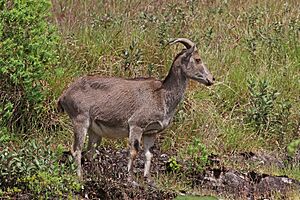Nilgiri tahr facts for kids
The Nilgiri tahr (Nilgiritragus hylocrius) is a special type of ungulate (a hoofed animal) that lives only in the Nilgiri Hills and the southern parts of the Western Ghats and Eastern Ghats. These areas are in the states of Tamil Nadu and Kerala in southern India. It is the only species in its group, called Nilgiritragus, and is closely related to sheep. The Nilgiri tahr is also the state animal of Tamil Nadu.
Quick facts for kids Nilgiri tahr |
|
|---|---|
 |
|
| Male (left) | |
 |
|
| Female in Eravikulam National Park | |
| Conservation status | |
| Scientific classification | |
 |
|
| Distribution of Nilgiri tahr | |
| Synonyms | |
|
Hemitragus hylocrius |
Contents
What's in a Name?
The name Nilgiritragus comes from two words. "Nilgiri" is a Tamil word meaning "blue hills." The second part, "tragos," is a Greek word that means "goat." So, its name basically means "goat of the blue hills."
Family Tree of the Nilgiri Tahr
Scientists used to think the Nilgiri tahr was part of the same group as the Himalayan tahr and the Arabian tahr. But in 2005, a study looked closely at their family trees. This study showed that the Nilgiri tahr is actually more closely related to sheep. Because of this, it was given its own special group called Nilgiritragus. This means it is the only species in that group.
Scientists believe the Nilgiri tahr separated from the common ancestor of sheep about 2.7 to 5.2 million years ago. Also, the groups of tahrs living in the Nilgiris (north) and Anamalais (south) separated about 1.5 million years ago.
Appearance and Features
The Nilgiri tahr is a strong, stocky animal. It has short, rough fur and a bristly mane around its neck. Male tahrs are bigger and darker than females when they are fully grown. Both males and females have curved horns. The horns of males can grow up to 40 centimeters (about 16 inches) long. Female horns are a bit shorter, reaching about 30 centimeters (about 12 inches).
Adult male tahrs are quite large. They can weigh between 80 to 100 kilograms (about 176 to 220 pounds). They stand about 100 centimeters (about 39 inches) tall at the shoulder. Older males get a light grey patch on their backs. This makes them look like they have a "saddle," so they are sometimes called "saddlebacks."
Where They Live
The Nilgiri tahr lives only in India. They prefer open grasslands in the mountains. These areas are part of the South Western Ghats montane rain forests. You can find them at high elevations, from 1,200 to 2,600 meters (about 3,900 to 8,500 feet). At these heights, the forests open up into large grasslands. These grasslands have small patches of stunted forests, which are called sholas.
In the past, Nilgiri tahrs roamed these grasslands in large groups. However, hunting and poaching in the 1800s greatly reduced their numbers.
Dangers They Face
The Nilgiri tahr faces several threats. Their homes are shrinking due to habitat loss. Other plants and animals that don't belong there are also causing problems. In some places, farm animals grazing, poaching, and their habitats being broken into smaller pieces also threaten them.
Protecting the Nilgiri Tahr
By the end of the 20th century, there were only about 100 Nilgiri tahrs left in the wild. Luckily, their numbers have started to grow since then. A study by WWF-India found that the population is now around 3,122.
Their home range stretches over 400 kilometers (about 250 miles) from north to south. Eravikulam National Park is home to the largest group of these animals. A wildlife count in 2014 showed that the number of tahrs in Eravikulam National Park had grown to 894. This was the highest number ever recorded there. The first count in 1996 found only 640 tahrs.
Other important groups of Nilgiri tahrs live in the Nilgiri Hills. Smaller groups can be found in the Anamalai Hills, Periyar National Park, Palani Hills, and other areas of the Western Ghats. A small group of about 200 tahrs lives in the Kanyakumari district of Tamil Nadu. Another small group of fewer than 30 animals lives in the Ponmudi Hills in Kerala.
See also
- Nilgiri Biosphere Reserve
- Wildlife of India




